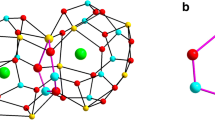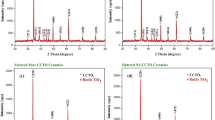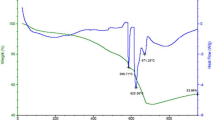Abstract
The present paper reports the structural, electronic and electrical conduction mechanisms of Ca2−xY2O5:xGd3+ (x = 0, 0.03 and 0.05 mol%) metal oxides synthesised by solid state reaction method. The computational crystal structure analysis confirms the formation of cubic structure along with space group Ia-3. The structural analysis confirms the shifting of the most intense peak towards the higher Bragg angle side. The morphological analysis shows the formation of clusters of grain of irregular shape and size. The frequency-dependent dielectric studies show that orientational and space charge polarisation are the dominant mechanisms in prepared compounds. The complex impedance spectroscopy shows that the conduction mechanism in Ca2−xY2O5:Gd3+ metal oxide is due to grain and grain boundary effect. The electrical modulus spectroscopy reveals the hopping of charge carriers between Ca2+ site and O2− site, respectively. The electrical conductivity in prepared metal oxide is due to small polaron hopping mechanism.















Similar content being viewed by others
References
Bredar, A.R.C., Chown, A.L., Burton, A.R., Farnum, B.H.: Electrochemical impedance spectroscopy of metal oxide electrodes for energy applications. ACS Appl. Energy Mater. 3, 66–98 (2020). https://doi.org/10.1021/acsaem.9b01965
Bansal, N.P.: Influence of several metal ions on the gelation activation energy of silicon tetraethoxide. J. Ame. Cera. Soc. 73, 2647–2652 (1990). https://doi.org/10.1111/j.1151-2916.1990.tb06741.x
Kuwabara, M., Ide, T.: CO gas sensitivity in porous semiconducting barium–titanate ceramics. Am. Ceram. Soc. Bull. 66, 1401–1405 (1987)
Chiu, C.M., Chang, Y.H.: The structure, electrical and sensing properties for CO of the La0.8Sr0.2Co1 – xNixO3 – δ system. Materials Science and Engineering A 266, 93–98 (1999)
Joseph, B., Gopchandran, K.G., Manoj, P.K.: Optical and electrical properties of zinc oxide films prepared by spray pyrolysis. Bull. Mater. Sci. 22, 921–926 (1999)
Dayan, N.J., Sainkar, S.R., Karekar, R.N.: Formulation and characterization of ZnO: Sb thick-film gas sensors. Thin Solid Films 325, 254–258 (1998)
Krishnan, B., Nampoori, V.P.N.: Screen printed nanosized ZnO thick film. Bull. Mater. Sci. 28, 239–242 (2005)
Som, S., Sharma, S.K.: Eu3+/Tb3+-codoped Y2O3 nanophosphors: Rietveld refinement, bandgap and photoluminescence optimization. J. Phys. D Appl. Phys. 45, 415102 (2012). https://doi.org/10.1088/0022-3727/45/41/415102
Qian, C., Zeng, T., Liu, H.: Synthesis and downconversion emission property of Yb2O3:Eu3+ nanosheets and nanotubes. Adv. Condens. Matter. Phys. 519869, 1–5(2013). https://doi.org/10.1155/2013/519869
Srinivasan, M.P., Punithavelan, N.: Structural, morphological and dielectric investigations on NiO/CuO/ZnO combined semiconductor metal oxide structures based ternary nanocomposites. Mater. Res. Express 5, 075033 (2018)
Mohamed, M.B., Sayed, K.E.: Structural, magnetic and dielectric properties of (PANI)–Ni0.5Zn0.5Fe1.5Cr0.5O4 nanocomposite. Composites Part B: Engineering 56, 270–278 (2014). https://doi.org/10.1016/j.compositesb.2013.08.038
Saxena, P., Choudhary, P., Yadav, A.: Effect of transition metal substitution on structural and dielectric properties of Mg0.5Zn0.5−xCrxCo2O4 (0.0 ≤ x ≤ 0.5) cobaltite. J Mater Sci: Mater Electron 30, 7292–7300 (2019). https://doi.org/10.1007/s10854-019-01042-4
Lakhane, M., Bogle, K., Khairnar, R., Dahiwale, S., Sharma, R., Mokale, V., Mahabole, M.: Dielectric properties of zeolite based metal oxide nanocomposites. Nano-Structures & Nano-Objects 17, 248–258 (2019). https://doi.org/10.1016/j.nanoso.2019.01.008
Tack, L.W., Azam, M.A., Seman, R.N.A.R.: Structural and electronic properties of transition-metal oxides attached to a single-walled CNT as a lithium-ion battery electrode: a first-principles study. J. Phys. Chem. A 121, 2636–2642 (2017). https://doi.org/10.1021/acs.jpca.6b12904
Skorodumova, N.V., Hermansson, K., Johansson, B.: Structural and electronic properties of the (100) surface and bulk of alkaline-earth metal oxides. Phys. Rev. B 72, 125414 (2005). https://doi.org/10.1103/PhysRevB.72.125414
Robertson, J.: High dielectric constant oxides. Eur. Phys. J. Appl. Phys. 28, 265–291 (2004). https://doi.org/10.1051/epjap:2004206
Dong, M., Wang, H., Ye, C., Shen, L., Wang, Y., Zhang, J., Ye, Y.: Structure and electrical properties of sputtered TiO2/ZrO2 bilayer composite dielectrics upon annealing in nitrogen. Nanoscale Res. Lett. 7, 1–5 (2012). http://www.nanoscalereslett.com/content/7/1/31
Choi, C., Lee, K.L., Narayanan, V.: Impact of diffusion less anneal using dynamic surface anneal on the electrical properties of a high-k/metal gate stack in metal-oxide-semiconductor devices. Appl. Phys. Lett. 98, 123506 (2011)
Das, T., Mahata, C., Maiti, C.K., Miranda, E., Sutradhar, G., Bose, P.K.: Effects of Ti incorporation on the interface properties and band alignment of HfTaOx thin films on sulfur passivated GaAs. Appl. Phys. Lett. 98, 022901 (2011)
Khomenkova, L., Portier, X., Marie, P., Gourbilleau, F.: Hafnium silicate dielectrics fabricated by RF magnetron sputtering. J. Non. Cryst. Solids 357, 1860 (2011)
Feng, X.Y., Shen, C., Fang, X., Chen, C.H.: Synthesis of LiNi0.5Mn1.5O4 by solid-state reaction with improved electrochemical performance. J. All. Comp. 509, 3623–3626 (2011). https://doi.org/10.1016/j.jallcom.2010.12.116
Parhi, P., Karthik, T.N., Manivannan, V.: Synthesis and characterization of metal tungstates by novel solid-state metathetic approach. J. All. Comp. 465, 380–386 (2008). https://doi.org/10.1016/j.jallcom.2007.10.089
Damien, B., Fabienne, A., Thibault, C., Dimitri, S., Didier, B.A.: Solid-state synthesis of monazite-type compounds LnPO4 (Ln = La to Gd). Sol. Stat. Sci. 9, 432–439 (2007). https://doi.org/10.1016/j.solidstatesciences.2007.03.019
Hohenberg, P., Kohn, W.: Inhomogeneous electron gas. Phys. Rev. 136, 1–8 (1964). https://doi.org/10.1103/PhysRev.136.B864
Rulis, P., Ouyang, L., Ching, W.Y.: Electronic structure and bonding in calcium apatite crystals: hydroxyapatite, fluorapatite, chlorapatite, and bromapatite. Phys. Rev. B 70, 155104 (2004). https://doi.org/10.1103/PhysRevB.70.155104
Roy, R.K., Hirao, K., Krishnamurty, S., Pal, S.: Mulliken population analysis based evaluation of condensed Fukui function indices using fractional molecular charge. Journal of chemical physics 11, 2901–2907 (2001). https://doi.org/10.1063/1.1386699
Jeria, J.S.G.: An empirical way to correct some drawbacks of Mulliken population analysis. J. Chil. Chem. Soc. 54, 482–485 (2009)
Stuchebrukhov, A.A.: Tunnelling currents in proteins: nonorthogonal atomic basis sets and Mulliken population analysis. J. Chem. Phys. 107, 6495–6498 (1997). https://doi.org/10.1063/1.474308
Gnanasekaran, L., Hemamalini, R., Saravanan, R., Ravichandran, K., Gracia, F., Agarwal, S., Gupta, V.K.: Synthesis and characterization of metal oxides (CeO2, CuO, NiO, Mn3O4, SnO2 and ZnO) nanoparticles as photo catalysts for degradation of textile dyes. J. Photochem. & Photobio. B: Biology 173, 43–49 (2017). https://doi.org/10.1016/j.jphotobiol.2017.05.027
Sudha, V., Murugadoss, G., Thangamuthu, R.: Structural and morphological tuning of Cu-based metal oxide nanoparticles by a facile chemical method and highly electrochemical sensing of sulphite. Sci Rep 11, 3431 (2021). https://doi.org/10.1038/s41598-021-82741-z
Landers, J., Ortiz, J.C., Zong, K., Goswami, A., Asefa, T., Vishnyakov, A., Neimark, A.V.: In situ growth and characterization of metal oxide nanoparticles within polyelectrolyte membranes. Wiley VCH (2016). https://doi.org/10.1002/anie.201606178
Hong, X., Liao, L.: Solution Processed Metal Oxide Thin Films for Electronic Applications. Metal Oxides Series 1, 31–39 (2020). https://doi.org/10.1016/B978-0-12-814930-0.00003-7
Li, H., Han, D., Dong, J., Yu, W., Liang, Y., Luo, Z., Zhang, S., Zhang, X., Wang, Y.: Enhanced electrical properties of dual-layer channel ZnO thin film transistors prepared by atomic layer deposition. Appl. Surf. Sci. 439, 632–637 (2018). https://doi.org/10.1016/j.apsusc.2017.12.234
Ruan, D.B., Liu, P.T., Gan, K.J., Chiu, Y.C., Yu, M.C., Chien, T.C., Chen, Y.H., YiKuo, P., Sze, S.M.: The influence on electrical characteristics of amorphous indium tungsten oxide thin film transistors with multi-stacked active layer structure. Thin Sol. Films 666, 94–99 (2018). https://doi.org/10.1016/j.tsf.2018.09.005
Yang, J., Hu, Y., Jin, C., Zhuge, L.: Xuemei Wu, Structural and optical properties of Er-doped TiO2 thin films prepared by dual-frequency magnetron co-sputtering. Thin Solid Films 637, 9–13 (2017). https://doi.org/10.1016/j.tsf.2017.03.012
Salama, A.H., Abdel-Karim, A.M.: Synthesis, characterization and dielectric properties of novel metal oxide–phthalocyanine nanocomposites. Egypt. J. Chem. 61, 281–294 (2018)
Guo, Z., Liu, A., Meng, Y., Fan, C., Shin, B., Liu, G., Shan, F.: Solution-processed ytterbium oxide dielectrics for low-voltage thin-film transistors and inverters. Ceramics Int. 43, 15194–15200 (2017). https://doi.org/10.1016/j.ceramint.2017.08.052
Kumar, A., Mondal, S., Rao, K.S.R.K.: Low temperature solution processed high-κ ZrO2 gate dielectrics for nanoelectonics. Appl. Sur. Sci. 370, 373–379 (2016). https://doi.org/10.1016/j.apsusc.2016.02.176
Zhang, Q., Xia, G., Xia, W., Zhou, J., Wang, S.: Low-temperature solution-processed high-k ZrTiOx dielectric films for high-performance organic thin film transistors. Synth. Met. 210, 282–287 (2015). https://doi.org/10.1016/j.synthmet.2015.10.011
Abdullah, M.M.: Facile growth, physical characterization, and dielectric response of as-grown NiO nanostructures. J. King Saud Uni. 32, 1048–1054 (2020). https://doi.org/10.1016/j.jksus.2019.09.009
Perumal, R., Thanikaikarasan, S.: Thickness, structural and optical properties of electrodeposited NiO thin films. Materials Today: Proceedings 33, 3989–3992 (2020). https://doi.org/10.1016/j.matpr.2020.06.337
Lanje, A.S., Sharma, S.J., Ningthoujam, R.S., Ahn, J.S., Pode, R.B.: Low temperature dielectric studies of zinc oxide (ZnO) nanoparticles prepared by precipitation method. Advanced Powder Tech. 24, 331–335 (2013). https://doi.org/10.1016/j.apt.2012.08.005
Rai, P., Yu, Y.T.: Citrate-assisted hydrothermal synthesis of single crystalline ZnO nanoparticles for gas sensor application. Sens. & Actu. B: Chem. 173, 58–65 (2012). https://doi.org/10.1016/j.snb.2012.05.068
Ameen, S., Akhtar, M.S., Song, M., Shin, H.S.: Metal oxide nanomaterials, conducting polymers and their nanocomposites for solar energy. InTech Open 1, 203–259 (2013). https://doi.org/10.5772/51432
Skotheim, T.A., Reynolds, J.R.: Handbook of Conducting Polymers: Conjugated Polym. CRC Press, Boca Raton (2007)
Hossen, M.B., Hossain, A.K.M.A.: Complex impedance and electric modulus studies of magnetic ceramic Ni0.27Cu0.10Zn0.63Fe2O4. J. Adv. Ceram. 4, 217–225 (2015). https://doi.org/10.1007/s40145-015-0152-2
Kumar, A., Singh, B.P., Choudhary, R.N.P., Thakur, A.K.: Characterization of electrical properties of Pb-modified BaSnO3 using impedance spectroscopy. Mater. Chem. Phys. 99, 150–159 (2006).https://doi.org/10.1016/j.matchemphys.2005.09.086
Das, P.S., Chakraborty, P.K., Behera, B., Mohanty, N.K., Choudhary, R.N.P.: Impedance spectroscopy study of Na2SmV5O15 ceramics. J. Adv. Ceram. 3, 1–6 (2014). https://doi.org/10.1007/s40145-014-0087-z
Lanfredi, S., Nobre, M.A.D.L.: Dielectric dispersion in Bi3 Zn2 Sb3 O14 ceramic: a pyrochlore type phase. Mat. Res. 6 (2003) 157–161,10.1590/ S1516-14392003000200008.[39] D.C. Sinclair, A.R. West, Impedance and modulus spectroscopy of semiconducting BaTiO3 showing positive temperature coefficient of resistance. J. Appl. Phys.66, 3850–3857 (1989).https://doi.org/10.1063/1.344049
Płcharski, J., Weiczorek, W.: PEO based composite solid electrolyte containing nasicon. Solid State Ionics 28,979–982 (1988).https://doi.org/10.1016/0167-2738(88)90315-3
Singh, H., Kumar, A., Yadav, K.L.: Structural, dielectric, magnetic, magnetodielectric and impedance spectroscopic studies of multiferroic BiFeO3–BaTiO3 ceramics. Mater. Sci. Eng. 176, 540–547 (2011). https://doi.org/10.1016/j.mseb.2011.01.010
Beg, S., Areqi, N.A.S.A., Haneef, S.: Haneef, Study of phase transition and ionic conductivity changes of Cd-substituted Bi4V2O11 – δ. Solid State Ionics 179, 2260–2264 (2008).https://doi.org/10.1016/j.ssi.2008.08.008
Dasari, M.P., Godavarti, U., Mote, V.: Structural, morphological, magnetic and electrical properties of Ni-doped ZnO nanoparticles synthesized by co-precipitation method. Process. Appl. Ceram 12, 100–110 (2018). https://doi.org/10.2298/PAC1802100D
Roling, B.: Scaling properties of the conductivity spectra of glasses and super cooled melts. Solid State Ionics 105, 185–193 (1998).https://doi.org/10.1016/S0167-2738(97)00463-3
Liu, J., Duan, C.G., Yin, W.G., Mei, W.N., et al.: Dielectric permittivity and electric modulus in Bi2Ti4O11. J. Chem. Phys. 119, 2812–2819 (2003).https://doi.org/10.1063/1.1587685
Bag, S., Das, P., Behera, B.: AC impedance spectroscopy and conductivity studies of Dy doped Bi4V2O11 ceramics. J. Theor. Appl. Phys. 11, 13–25 (2017). https://doi.org/10.1007/s40094-017-0246-z
Shamim, M.K., Sharma, S., Sinha, S., Nasreen, E.: Dielectric relaxation and modulus spectroscopy analysis of (Na0:47 K0:47 Li0:06) NbO3 ceramics. J. Adv. Dielectr. 7, 1750020–1750031 (2017).https://doi.org/10.1142/S2010135X17500205
Richert, R., Wagner, H.: The dielectric modulus: relaxation versus retardation. Solid State Ionics 105,167–173 (1998)
Tsangaris, G.M., Psarras, G.C., Kouloumbi, N.: Electric modulus and interfacial polarization in composite polymeric systems. J. Mat. SCI. 33, 2027–2037 (1998)
Behera, B., Nayak, P., Choudhary, R.N.P.: Studies of dielectric and impedance properties of KCa2V5O15 ceramics. J. Phy & Chem. Solids 69, 1990–1995 (2008).https://doi.org/10.1016/j.jpcs.2008.02.013
Barik, S.K., Mahapatra, P.K., Choudhary, R.N.P.: Structural and electrical properties of Na1/2La1/2TiO3 ceramics. Appl. Phys. A 11, 199–203 (2006). https://doi.org/10.1007/s00339-006-3668-z.
Cao, M.S., Hou, Z.L., Yuan, J., Xiong, L.T., Shi, X.L.: Low dielectric loss and non-Debye relaxation of gamma-Y2Si2O7 ceramic at elevated temperature in X-band. J. Appl. Phys.105, 106102 (2009).https://doi.org/10.1063/1.3117525
Cao, M.S., Hou, Z.L., Yuan, J., et al.: The effects of temperature and frequency on the dielectric properties, electromagnetic interference shielding and microwave-absorption of short carbon fiber/silica composites. Carbon 48, 788–796 (2010).https://doi.org/10.1016/j.carbon.2009.10.028
Özdemir, Z.G., Kılıç, M., Karabul, Y.S., Erd¨onmez, S., Içelli, O.: The influence of the partially europium substitution on the AC electrical properties of BiSr2CaCu2O6.5 ceramics. Process. Appl. Ceram. 13, 323–332 (2019). https://doi.org/10.2298/PAC1904323O
Jonscher, A.K.: The ‘universal’dielectric response. Nature 267, 673–679 (1977).https://doi.org/10.1109/CEIDP.1990.201316
Funke, K.: Jump relaxation in solid electrolytes. Prog. Solid State Chem. 22, 111–195 (1993).https://doi.org/10.1016/0079-6786(93)90002-9
Elliot, S.R.: A.c. conduction in amorphous chalcogenide and pnictide semiconductors. Adv. Phys. 36, 135–217 (1987).https://doi.org/10.1080/00018738700101971
Roy, A.K., Singh, A., Kumari, K., Nath, K.A., Prasad, A., Prasad, K.: Electrical properties and AC conductivity of (Bi0.5Na0.5)0.94Ba0.06TiO3 ceramic. ISRN Ceramics 2012, 854831–854841 (2012).https://doi.org/10.5402/2012/854831
Maldzius, R., Sirviö, P., Sidaravicius, J., Lozovski, T., Backfolk, K., Rosenholm, J.B.: Temperature-dependence of electrical and dielectric properties of papers for electrophotography. J. Appl. Phys. 107, 114904 (2010).https://doi.org/10.1063/1.3386466
Author information
Authors and Affiliations
Corresponding author
Ethics declarations
Conflict of interest
The author declares no competing interests.
Additional information
Publisher's note
Springer Nature remains neutral with regard to jurisdictional claims in published maps and institutional affiliations.
Rights and permissions
About this article
Cite this article
Agrawal, S. Structural, electronic and electrical conduction behaviour of Gd3+ doped Ca2−xY2O5 metal oxide ceramic synthesised by solid state reaction method. J Aust Ceram Soc 58, 683–697 (2022). https://doi.org/10.1007/s41779-022-00720-7
Received:
Revised:
Accepted:
Published:
Issue Date:
DOI: https://doi.org/10.1007/s41779-022-00720-7




